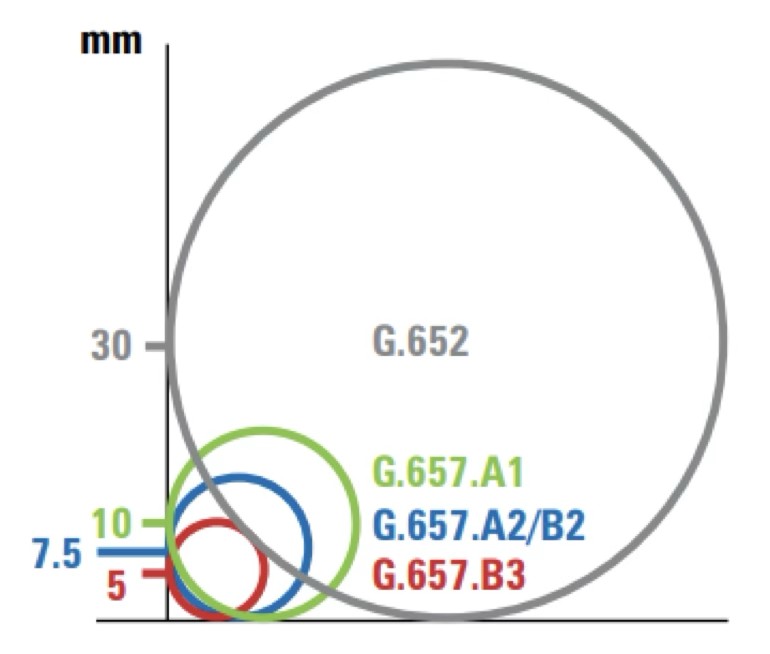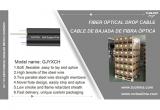
Single-mode fibers, which support only one propagation mode in each polarization direction at a given wavelength, are widely used in optical communication. According to ITU-T recommendations, single-mode fibers are classified into six types: G.652 (dispersion-unshifted single-mode fiber), G.653 (dispersion-shifted fiber), G.654 (cutoff wavelength-shifted fiber), G.655 (non-zero dispersion-shifted fiber), G.656 (low-slope non-zero dispersion-shifted fiber), and G.657 (bend-insensitive fiber). Among these, G.652 and G.655 are the most common types of single-mode fibers. This article will provide a detailed explanation of the classification and differences between G.652 and G.655 single-mode fibers.
G.652 Single-Mode Fiber Types
In 1984, ITU-T introduced the first version of G.652 single-mode fiber, which underwent five revisions in 1988, 1992, 1996, 2000, and 2003, with the sixth revision being released in 2005, forming the latest version (the seventh edition). In the sixth edition, G.652 single-mode fiber was classified into four types: G.652A, G.652B, G.652C, and G.652D, with core diameters ranging from 8 to 10μm.
G.652A and G.652B single-mode fibers have a zero dispersion wavelength around 1310nm, making them ideal for applications in the 1310nm band. However, due to their water absorption peak characteristics, G.652A and G.652B are unsuitable for wavelength division multiplexing (WDM) applications.
G.652C and G.652D single-mode fibers have lower attenuation coefficients at 1550nm and eliminate the water absorption peak near 1380nm. These fibers can work in the 1360nm–1530nm wavelength range, supporting WDM transmission. Among them, G.652D is the most stringent in terms of specifications and is fully backward compatible. Structurally, it is identical to standard G.652 fiber and is the most advanced non-dispersion-shifted fiber currently used in metropolitan networks.
G.655 Single-Mode Fiber Types
G.655 single-mode fiber was specifically designed in 1994 for the next generation of optical amplifier-based dense wavelength division multiplexing (DWDM) transmission systems. It is divided into several types: G.655A, G.655B, G.655C, G.655D, and G.655E. Among these, G.655C, G.655D, and G.655E are the most commonly used types.
G.655 single-mode fiber is known as non-zero dispersion-shifted fiber (NZDSF), because it has near-zero dispersion at the 1550nm wavelength, which is ideal for DWDM systems. It can be further categorized into (-D) NZDSF and (+D) NZDSF, which represent fibers with negative and positive dispersion slopes, respectively.
Compared to G.652 single-mode fiber, G.655 single-mode fiber has lower dispersion in the C-band (1530nm–1565nm), which maximizes the performance of optical amplifiers in that wavelength range. Additionally, G.655 fiber has a larger core area. As an improved version of dispersion-shifted fiber, G.655 reduces non-linear effects such as four-wave mixing and is suitable for long-distance and high-capacity applications, meeting the needs of DWDM networks.
G.652 vs G.655 Single-Mode Fiber: How to Choose?
G.652 Single-Mode Fiber is typically used in local area networks (LANs), metropolitan area networks (MANs), access networks, and coarse wavelength division multiplexing (CWDM) transmissions. Coarse WDM is an economical and efficient solution, and G.652 is often used for short-distance transmission where optical signal amplification is unnecessary.
G.655 Single-Mode Fiber, on the other hand, is the second most common fiber type used in terrestrial networks. Its primary feature is low dispersion (both chromatic dispersion and polarization mode dispersion), making it ideal for long-distance transmission and dense wavelength division multiplexing (DWDM) systems.
G.652 single-mode fiber and its upgraded version, G.657, are cost-effective standard fibers that are highly suitable for short-distance transmissions with transmission speeds below 10Gbps. If your network's transmission speed exceeds 10Gbps or requires long-distance transmission, G.655 single-mode fiber is an excellent choice, especially when cost is not a major concern.
Conclusion
As we have discussed, different types of single-mode fibers serve different purposes. For long-distance transmission, choosing the appropriate single-mode fiber is crucial. In practical applications, performance, cost, reliability, and security should be considered. For medium to short-distance transmissions (e.g., 2km) with lower transmission speeds (e.g., 10Gbps), G.652 single-mode fiber is a good cost-effective choice. However, for higher transmission speeds (above 10Gbps) and longer transmission distances (over 40km), G.655 single-mode fiber offers an excellent solution.
Related Products
IP68 Fiber Optic Splice Closures — Designed to provide secure and reliable protection for fiber optic joints
Aug 02-2024

Enhancing Campus Connectivity: GJYXCH Fiber Optic Cable in Educational Networks
Jan 09-2024

Elevating Urban Infrastructure: GJYXCH Fiber Optic Cable in Smart City Networks
Jan 07-2024